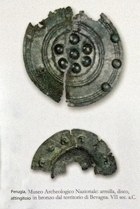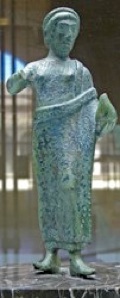This page describes objects not currently on display, as well as those that I have not yet tracked down.
Bevagna
Bronze discs (7th century BC)

Bettona
Sextus Valerius Proculus (early 1st century AD)
This inscription (CIL XI 7979) was discovered in the Ipogeo di Colle, Bettona. It reads:
SEX- VALERIVS SEX--
F- CLV- PROCVLVS
PR- ETRVRIAE
II- VIR
It commemorates Sextus Valerius Proculus, son of Sextus, who had belonged to the the Clustumina Tribe and had been a duumrvir and praetor Etruriae.
Corciano
Votive bronze (late 5th century BC)

Gualdo Tadino
Votive bronze (early 5th century BC)
This votive bronze figure was discovered in 1959 in Taino, near Gualdo Tadino, which was later the site of Roman Tadinum.
Civitella d’ Arno
Supports funerary bed (ca. 100 BC)
These two bronze supports from a funerary bed were found in 1787, apparently at Civitella d’ Arno. Each has the head of a lion at its upper end and the head of a woman below.
Nocera Umbra
Finds from the Portone Necropolis (ca. 570 –670 AD)

This Lombard necropolis was discovered near Nocera Umbra in 1897.
Return to the main page on Museo Archeologico.



